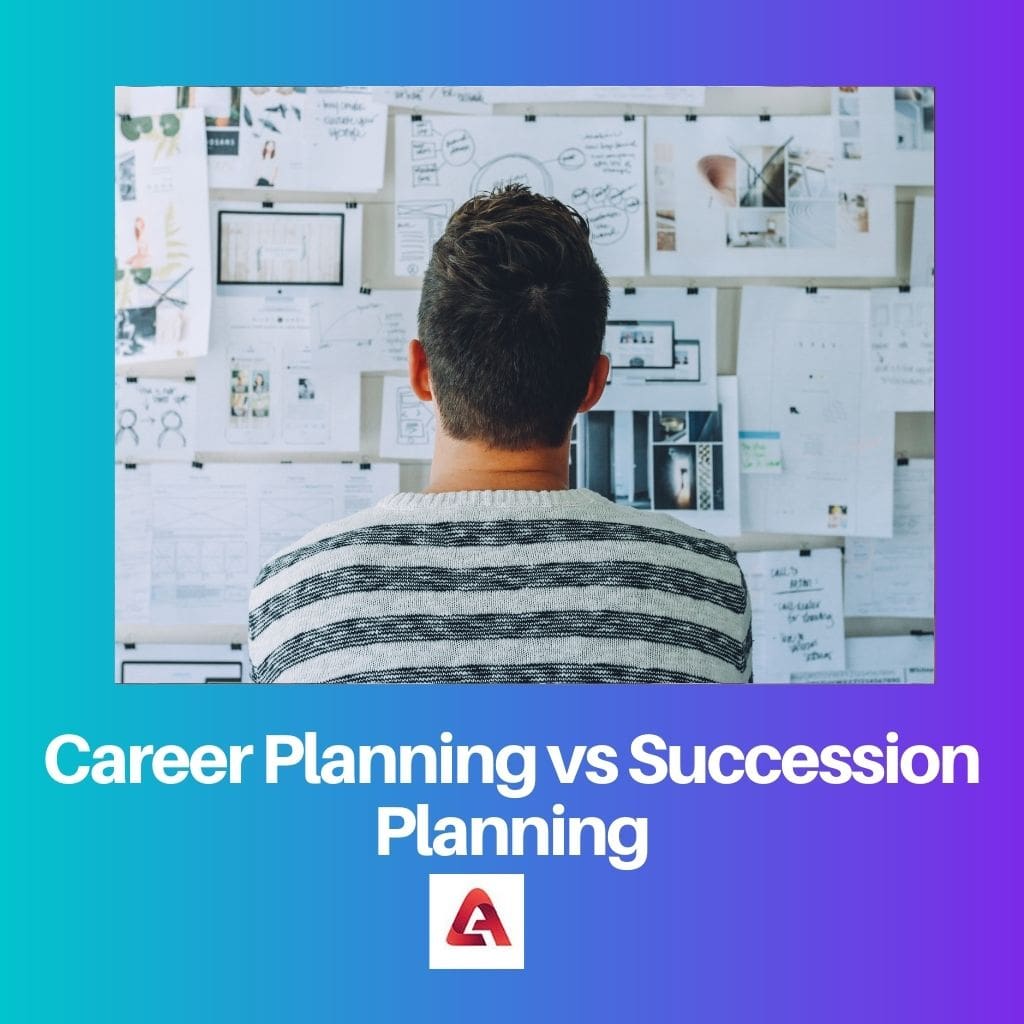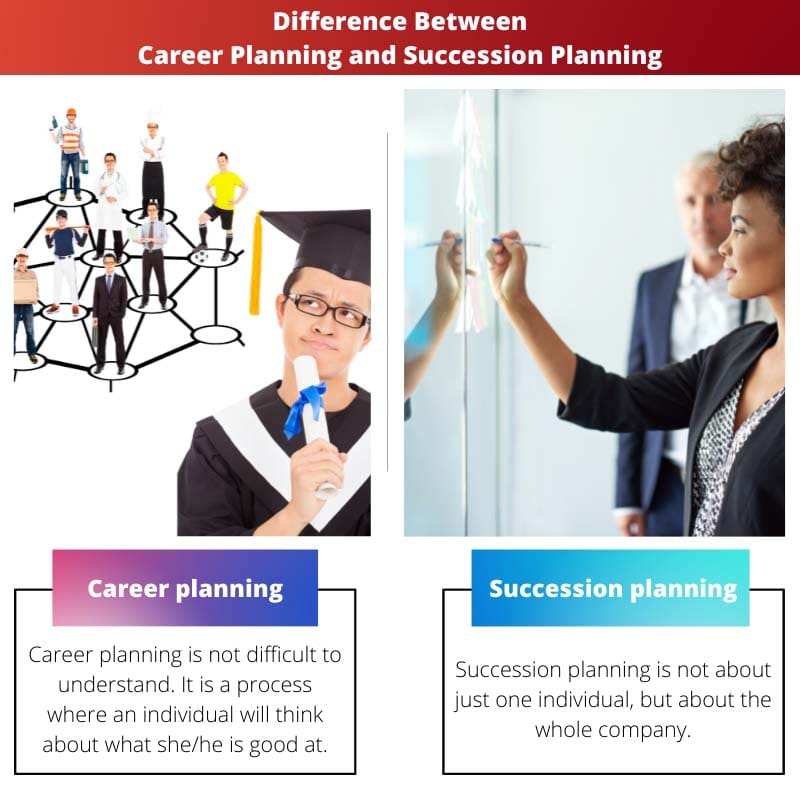Career planning involves an individual’s proactive efforts to set and achieve career goals. In contrast, succession planning focuses on an organization’s strategic identification and development of potential leaders to ensure a smooth transition of key roles.
Key Takeaways
- Career planning is the process of identifying and developing career goals and strategies. In contrast, succession planning identifies and prepares potential successors for critical organizational positions.
- Career planning is focused on individual development and growth, while succession planning is focused on organizational continuity and stability.
- Career planning is driven by individual initiative and ambition, while organizational needs and objectives drive succession planning.
Career Planning vs Succession Planning
Career planning involves identifying an individual’s strengths, interests, and goals, and developing a plan to help them achieve their career aspirations. Succession planning is a systematic process of identifying employees with the potential to fill key leadership positions in an organization.

Since we have given you a gist about career and succession planning, read more to know about both in detail.
Comparison Table
| Feature | Career Planning | Succession Planning |
|---|---|---|
| Focus | Individual’s long-term career goals and development | Ensuring continuous leadership and talent replacement within an organization |
| Driven by | Individual’s aspirations, skills, and interests | Organizational needs and future leadership requirements |
| Perspective | Bottom-up approach, identifying opportunities for growth and advancement | Top-down approach, anticipating future vacancies and identifying potential successors |
| Timeframe | Ongoing and evolving throughout an individual’s career | Long-term planning, looking 3-5 years or more ahead |
| Activities | Setting career goals, identifying skills gaps, seeking training and development opportunities, building professional networks | Identifying high-potential employees, developing leadership skills through workshops and mentorship, creating talent pools for key positions, assessing readiness for succession |
| Benefits | Increased employee engagement, retention, and satisfaction, improved individual performance, greater career agility | Organizational stability, continuity of leadership, reduced risk of disruption, smoother transitions during leadership changes |
| Key outcomes | Individual career advancement, skill development, and fulfillment | Sustainable talent pipeline, prepared future leaders, effective succession for key positions |
What is Career Planning?
Career planning is a systematic process of setting individual career goals and strategically managing professional development to achieve those goals. It involves a thoughtful consideration of one’s skills, interests, values, and aspirations, as well as an awareness of the external factors that may impact one’s career path. Effective career planning enables individuals to make informed decisions about their career trajectories, navigate transitions, and pursue opportunities that align with their personal and professional objectives.
Key Components of Career Planning
Self-Assessment
Career planning begins with a thorough self-assessment. This involves identifying and evaluating strengths, weaknesses, skills, interests, and values. Understanding personal preferences and aptitudes lays the foundation for making informed career choices.
Goal Setting
Establishing clear and realistic career goals is a crucial step in the planning process. Goals should be specific, measurable, achievable, relevant, and time-bound (SMART). These objectives provide a roadmap for professional development and guide decision-making.
Research and Exploration
Conducting research about various career options and industries is essential. This includes gathering information about job responsibilities, required qualifications, industry trends, and potential growth opportunities. Exploring different paths helps individuals make well-informed decisions.
Skill Development
Identifying the skills necessary for success in a chosen field and actively developing those skills is a continuous aspect of career planning. This may involve acquiring additional education, training, certifications, or hands-on experience to enhance professional competencies.
Networking
Building a professional network is a critical element of career planning. Networking provides opportunities for mentorship, exposure to industry insights, and access to potential job opportunities. Establishing and nurturing professional relationships can contribute significantly to career advancement.
Resume Building
Crafting an effective resume that highlights relevant skills, experiences, and achievements is vital for career planning. Regularly updating and tailoring the resume ensures that it accurately reflects an individual’s evolving professional profile.
Adaptability and Flexibility
Given the dynamic nature of the job market, career planning also involves developing adaptability and flexibility. Being open to change, acquiring new skills, and embracing emerging opportunities contribute to long-term career success.
Importance of Career Planning
- Provides Direction: Helps individuals set a clear career direction, preventing aimless drifting and fostering purposeful decision-making.
- Facilitates Decision-Making: Enables individuals to make informed decisions about education, training, job changes, and other career-related choices.
- Enhances Job Satisfaction: Aligning one’s career with personal values and interests increases job satisfaction and overall well-being.
- Promotes Professional Growth: Supports continuous learning and development, ensuring individuals remain competitive in their chosen fields.
- Mitigates Career Transitions: Equips individuals with the skills and knowledge needed to navigate career transitions, whether changing industries or pursuing advanced roles.

What is Succession Planning?
Succession planning is a strategic process within organizations to identify and develop internal talent to fill key leadership positions when they become vacant. It involves systematically preparing for the turnover of key roles due to retirements, promotions, or unexpected departures, ensuring a smooth transition and continuity of organizational effectiveness.
Key Components of Succession Planning
1. Identification of Key Positions: The process begins by identifying critical organizational roles and positions. These are leadership or specialized positions vital to the business’s overall functioning and success.
2. Talent Assessment: Organizations assess their current talent pool to identify individuals with the potential to assume key roles in the future. This involves evaluating skills, competencies, and leadership qualities.
3. Leadership Development: Once high-potential individuals are identified, organizations invest in their development through training, mentoring, and other developmental programs. The goal is to groom these individuals for leadership positions.
4. Succession Pools: Succession planning involves creating pools of potential successors for specific roles. These pools provide a structured approach to nurturing and preparing individuals for advancement.
5. Regular Review and Updates: Succession plans are not static; they require regular review and updates. Changes in organizational goals, leadership needs, or unexpected events may necessitate adjustments to the succession strategy.
6. Communication and Transparency: Open communication about succession planning is crucial. Employees should know the organization’s commitment to talent development and understand how the process works. Transparency fosters trust and engagement.
7. Evaluation of External Talent: While internal talent development is a key focus, succession planning may also involve considering external candidates when necessary. This ensures a broader perspective and diverse skill sets.
Benefits of Succession Planning
1. Continuity and Stability: Succession planning ensures that the organization is prepared for leadership transitions, reducing disruptions and maintaining stability during periods of change.
2. Talent Retention: Employees are more likely to stay with an organization that invests in their professional development and provides a clear path for career advancement.
3. Improved Organizational Performance: Effective succession planning contributes to a more skilled and capable workforce. This, in turn, enhances organizational performance and adaptability.
4. Strategic Alignment: Succession planning aligns talent development with the organization’s strategic objectives, ensuring that future leaders can drive the company’s success.
5. Leadership Pipeline: By establishing a pipeline of skilled leaders, organizations can respond more proactively to unexpected leadership changes and promote a culture of continuous improvement and growth.

Main Differences Between Career Planning and Succession Planning
- Focus:
- Career planning primarily focuses on individual development and advancement within an organization, aligning an individual’s skills, interests, and goals with available opportunities.
- Succession planning, on the other hand, concentrates on identifying and developing potential successors for key positions within the organization to ensure continuity in leadership and critical roles.
- Scope:
- Career planning encompasses the entire career journey of an individual within an organization, including goal setting, skill development, performance management, and advancement opportunities.
- Succession planning specifically targets key leadership positions and critical roles within the organization, ensuring that there are suitable candidates ready to step into these positions when needed.
- Time Horizon:
- Career planning focuses on both short-term and long-term career goals of individuals, spanning their entire career trajectory within the organization.
- Succession planning tends to have a more strategic and long-term focus, anticipating future leadership needs and grooming potential successors over an extended period.
- Individual vs. Organizational Perspective:
- Career planning is primarily driven by the individual’s aspirations, skills, and career goals, with a focus on personal development and advancement.
- Succession planning is driven by organizational needs and objectives, aiming to ensure the continuity of leadership and critical roles to support the organization’s strategic goals and operations.
- Approach:
- Career planning involves collaborative discussions between employees and their supervisors or HR professionals, focusing on identifying career goals, development needs, and opportunities within the organization.
- Succession planning involves a more structured and systematic approach, including talent assessments, identification of high-potential employees, and targeted development initiatives to groom future leaders.
- Risk Management:
- Succession planning plays a critical role in risk management by ensuring that the organization has a pipeline of qualified candidates ready to fill key positions in case of unexpected vacancies or leadership transitions.
- While career planning contributes to employee engagement and retention, it may not directly address the organization’s succession needs unless aligned with broader talent management strategies.
- Performance Implications:
- Effective career planning can lead to improved employee satisfaction, engagement, and performance by aligning individual aspirations with organizational goals and providing opportunities for growth.
- Succession planning helps mitigate risks associated with leadership gaps, ensuring continuity in operations and maintaining organizational performance during leadership transitions.



